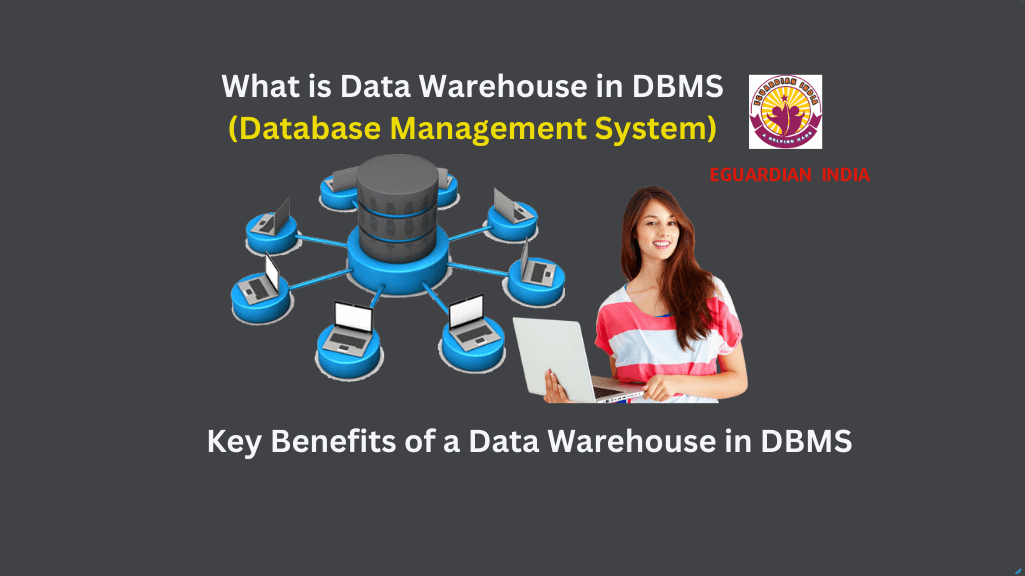What is Data Warehouse in DBMS (Database Management System) with Uses, Benefits and Futures!

In modern data management, the term “Data Warehouse” holds a significant place, especially within the context of Database Management Systems (DBMS).
A Data Warehouse in DBMS is not just a repository for data; it is a strategic component that empowers organizations to unlock valuable insights, drive informed decision-making, and enhance overall business intelligence.
What is Data Warehouse in DBMS (Database Management System)
Understanding the Data Warehouse
At its core, a Data Warehouse in DBMS is a specialized repository designed to store, manage, and organize large volumes of data from diverse sources within an organization.
Unlike operational databases that handle day-to-day transactions, a Data Warehouse is optimized for analytical tasks, such as complex queries, data mining, and reporting. It acts as a bridge between raw data and actionable insights, providing a structured environment for data analysis.
The Purpose and Importance of Data Warehouse in DBMS
The primary purpose of a Data Warehouse in DBMS is to facilitate efficient data analysis and reporting. By integrating data from various sources – be it sales, inventory, customer interactions, or market trends – a Data Warehouse offers a consolidated view of an organization’s historical performance.
This enables decision-makers to understand trends, patterns, and opportunities comprehensively, thereby driving strategic planning.
A data warehouse plays a crucial role in a database management system (DBMS) by serving as a central repository for storing and organizing large volumes of structured and unstructured data.
By consolidating data from various sources and transforming it into a consistent format, a data warehouse enables users to analyze trends, identify patterns, and gain valuable insights into the organization’s operations.
This centralized approach to data storage not only enhances data quality and consistency but also improves the efficiency of reporting and analytics processes within an organization. Ultimately, the importance of a data warehouse in a DBMS lies in its ability to support strategic decision-making, drive business growth, and enhance overall operational performance.
Data Warehouse is in the context of a Database Management System (DBMS):
- Definition: A Data Warehouse in a Database Management System (DBMS) refers to a specialized database that is optimized for analytical and reporting purposes.
- Purpose: Unlike transactional databases, which focus on day-to-day operations, a Data Warehouse serves as a repository for historical and aggregated data used for strategic decision-making.
- Data Integration: Data from various operational sources is extracted, transformed, and loaded (ETL) into the Data Warehouse to create a unified and consistent view.
- Schema Design: Data Warehouses often use schemas like star schema or snowflake schema to organize data into dimensions and facts, enabling efficient querying.
- Data Storage: Data in a Data Warehouse is structured in a way that supports complex queries and aggregations, making it suitable for business analysis.
- Query Performance: Indexing, partitioning, and optimization techniques are applied to ensure fast query performance, even over large datasets.
- Historical Analysis: Data Warehouses store historical data, allowing organizations to analyze trends, make comparisons, and understand long-term patterns.
- Business Intelligence: Data from a Data Warehouse is used for generating reports, creating dashboards, and performing advanced analytics to support business intelligence initiatives.
- Decision Support: A Data Warehouse in a DBMS provides decision-makers with insights and information needed for strategic planning and informed choices.
- Example: A retail company might use a Data Warehouse to analyze sales data over multiple years to identify seasonal trends, top-selling products, and customer behavior.
Key Benefits of a Data Warehouse in DBMS:
- Unified View: A Data Warehouse centralizes data from multiple sources, ensuring consistency and accuracy.
- Analytical Depth: It enables complex queries and data mining, uncovering hidden insights within the data.
- Historical Context: Data Warehouses retain historical data, allowing for trend analysis and performance evaluation over time.
- Informed Decision-Making: Decision-makers can generate customized reports and visualizations for actionable insights.
- Enhanced Business Intelligence: Data Warehouses support strategic planning, forecasting, and resource allocation.
How a Data Warehouse Works
The journey of data within a Data Warehouse involves several stages:
- Data Extraction: Raw data is collected from various sources, including operational databases, spreadsheets, and external systems.
- Data Transformation: The data undergoes cleansing, normalization, and transformation to ensure consistency and quality.
- Data Loading: Transformed data is loaded into the Data Warehouse and organized into tables optimized for analysis.
- Data Analysis: Users employ complex queries and analytical tools to explore the data and derive insights.
- Data Presentation: The insights are visualized through reports, dashboards, and visualizations for decision-makers.
FAQs
Q1: Is a Data Warehouse the same as an operational database in a DBMS?
No, a DataWarehouse in DBMS is distinct from operational databases. While operational databases handle day-to-day transactions, Data Warehouses focus on data analysis and reporting.
Q2: How does a Data Warehouse support decision-making?
A Data Warehouse empowers decision-makers to make informed choices based on trends and insights by providing a unified and historical view of data.
Q3: What is the role of a Data Warehouse in business intelligence?
A Data Warehouse enhances business intelligence by enabling strategic planning, performance measurement, and predictive analytics.
Q4: Can a Data Warehouse handle real-time data?
While some Data Warehouses support near-real-time data, they are generally optimized for historical and large-scale data analysis.
Q5: What are the challenges of implementing a Data Warehouse in a DBMS?
One of the key challenges in implementing a Data Warehouse in a DBMS is the complexity of data integration. Different sources often have varying data formats, structures, and quality levels, making it difficult to consolidate data into a cohesive warehouse. This can result in inconsistencies and errors that need to be resolved during the ETL (Extract, Transform, Load) process.
Conclusion
In short, a Data Warehouse within a DBMS is a specialized system designed to store historical and summarized data, fine-tuned for analytical needs. It serves a vital role in improving decision-making by offering a complete, organized view of an organization’s data, making deep analysis and detailed reporting much easier.
It acts as a catalyst for transforming raw data into actionable insights. Organizations can navigate the complexities of today’s data-driven landscape by consolidating and organizing data for analysis.
With its ability to support complex queries, data mining, and reporting, a Data-Warehouse in DBMS becomes an indispensable tool for unlocking the full potential of data and driving strategic decision-making.



